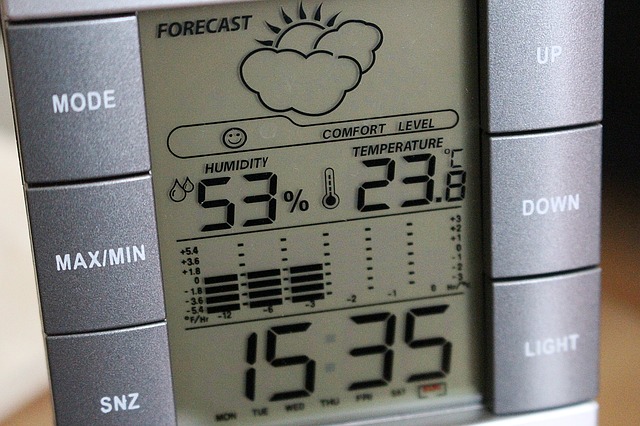Humidity
Air will generally include moisture in the form of water vapour. Absolute humidity is the mass of water vapour in a volume of air divided by the mass of dry air.
Relative humidity (RH) is a measure of the water vapour density of air compared to the water vapour density for saturated air at the same temperature and pressure (that is, the maximum amount of moisture that air can 'hold' at that temperature and pressure). It is expressed as a percentage.
RH = (actual water vapour density / saturation water vapour density) x 100
When air cools, it is less able to “hold” moisture, that is, the saturation water vapour density falls, and so relative humidity rises. When the relative humidity reaches 100%, the air will be saturated. This is described as the dew point. If the air continues to cool, moisture will begin to condense.
Humidity influences thermal comfort. The higher the relative humidity, the less heat a person is able to lose through the evaporation of moisture on the skin, and so the hotter they will feel. Conversely, air that is too dry can cause problems such as dry eyes, nose, ears and throat. Typically, a relative humidity of 40 to 60% is appropriate in many buildings.
Humidity also affects the performance of buildings, causing condensation, mould growth, mildew, staining, slip hazards, damage to equipment and the corrosion and decay of the building fabric as well as poor performance of insulation. Condensation can occur on surfaces, or can be interstitial condensation, occurring between the layers of the building envelope, typically as a result of air diffusing from the warm interior of the building to the cool exterior and reaching its dew point within the building fabric.
Humidity can be measured using a hygrometer. Typically these are electronic moisture detectors, or devices such as a sling psychrometer which measures dry-bulb temperature and wet-bulb temperature, allowing relative humidity to be calculated or read from charts.
Humidity can be controlled by limiting sources of moisture (including reverse condensation, where moisture evaporates from damp materials), increasing temperatures, humidification or dehumidification, and by ventilation. Condensation can be further avoided by increasing surface temperatures (such as by the inclusion of insulation or by improving glazing).
In particular, it is necessary to avoid cold bridges, situations in a building where there is a direct connection between the inside and outside through one or more elements that are more thermally conductive than the rest of the building envelope, resulting in lower localised temperatures.
Humidity and condensation in buildings is regulated by Approved Document C (Site preparation and resistance to contaminates and moisture) and Approved Document F (Ventilation) and further guidance is available in BS 5250 Code of practice for the control of condensation in buildings.
NB Illustrated Guide to Mechanical Cooling (BG 1/2010), written by Kevin Pennycook and published by BSRIA in 2010, defines Relative humidity as: ‘A term often used to specify the internal design condition for humidity within a space. A ratio, usually expressed as a percentage, indicating the humidity of the air. Literally the actual vapour pressure of the air at a given dry bulb temperature divided by the saturation vapour pressure of the air at the same temperature.’
[edit] Related articles on Designing Buildings
- Air conditioning.
- Approved Document F.
- Condensation.
- Damp proofing.
- Dehumidification.
- Designing HVAC to resist harmful microorganisms.
- Dew point.
- Diagnosing the causes of dampness (GR 5 revised).
- Dry-bulb temperature.
- Humidification.
- Humidistat.
- HVAC.
- Interstitial condensation.
- Methodology for moisture investigations in traditional buildings.
- Moisture.
- Moisture content.
- Mould growth.
- Psychometric chart.
- Rising damp.
- Sling psychrometer.
- Thermal comfort.
- Thermal indices.
- Water vapour.
- Wet-bulb temperature.
Featured articles and news
Infrastructure that connect the physical and digital domains.
Harnessing robotics and AI in challenging environments
The key to nuclear decommissioning and fusion engineering.
BSRIA announces Lisa Ashworth as new CEO
Tasked with furthering BSRIA’s impressive growth ambitions.
Public buildings get half a million energy efficiency boost
£557 million to switch to cleaner heating and save on energy.
CIOB launches pre-election manifesto
Outlining potential future policies for the next government.
Grenfell Tower Inquiry announcement
Phase 2 hearings come to a close and the final report due in September.
Progress from Parts L, F and O: A whitepaper, one year on.
A replicated study to understand the opinion of practitioners.
ECA announces new president 2024
Electrical engineer and business leader Stuart Smith.
A distinct type of countryside that should be celebrated.
Should Part O be extended to existing buildings?
EAC brands heatwave adaptation a missed opportunity.
Definition of Statutory in workplace and facilities management
Established by IWFM, BESA, CIBSE and BSRIA.
Tackling the transition from traditional heating systems
59% lack the necessary information and confidence to switch.
The general election and the construction industry
As PM, Rishi Sunak announces July 4 date for an election.
Eco apprenticeships continue help grow green workforce
A year after being recognised at the King's coronation.
Permitted development rights for agricultural buildings
The changes coming into effect as of May 21, 2024.






















